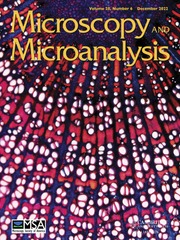No CrossRef data available.
Article contents
LVEDS For Advanced Materials and Semiconductor Technologies
Published online by Cambridge University Press: 02 July 2020
Extract
The need to analyze bulk samples containing features with submicron dimensions has driven revaluation of the processes controlling the interaction of electron beams with inorganic, polymer and semiconductor materials, and to development of LVEDS analysis at lower beam energies of E0 <5kV (1,2).
It has previously been shown (1,2) that the physics is much as expected with the vertical penetration range (R) along the beam direction in many cases predicted quite accurately for beam energy E0 by the simple Bethe (e.g. in 3) power law with R = F(E0)5/3. These same factors are effective to varying degrees in all three dimensions. The strong dependence of the range on energy has practical importance for the identification of sub-micron particles, including to help to determine the root cause of a defect Fig. 1 is an example of the sequential analysis of the exact same sub-micron particle, with the very real potential for a processing disaster, on the surface of a silicon wafer. When this feature is analyzed with a 3kV electron beam we learn it is alumina (A12O3). The analysis comes only from the target particle and the data have a simple relationship to the chemistry and the sensitivity for the light element (O) is excellent, providing simple and direct qualitative identification of the oxide compound.
- Type
- Low Voltage (1-5 kv) X-ray Microanalysis
- Information
- Copyright
- Copyright © Microscopy Society of America
References
1. Boyes, E D, Proc ICEM-12, Paris, (1994) 51Google Scholar
2. Boyes, E D, Advanced Materials, 10 (1998) 12773.0.CO;2-D>CrossRefGoogle Scholar
3. Reed, S J B, Microprobe Analysis, CUP, (1993)Google Scholar
4. Cliff, G and Lorimer, G, J of Micros, 103 (1975) 203CrossRefGoogle Scholar


